- Home |
- Why With Us |
- About Us |
- Booking |
- Contact Us |
- Site Map


Mera Trekking peak with Baruntse Base camp Trek
27 days (ktm-ktm) Days from
Trek Lukla to Hinku Valley & Mera Peak Base Camp with option to Summit Mera Peak (6476m) and to continue to Baruntse Base Camp, West Col, and over Amphu Lapsa to Chukung Valley
Mera Peak rises 12 km to the south of Mt Everest, dominating the remote and beautiful Hinku Valley. It has 3 distinct summits. We ascend Mera Central via a long broad ridge from Mera La pass on the northern face. A high camp is established at 5800m
| Max. Elevation : 6476m | Grade : Strenuous |
| Best season : Oct-Dec&Feb-May | Type of trek : Camping |
| Duration : 27 Days | Starting point : Lukla |
| Ending point : Kathmandu | Highlights : Nature |
This trekking cum mountaineering adventure ventures into the Hink and Hongu valley in the Everest region of Nepal. A remote and strenuous trek crossing a number of high passes and with the opportunity to summit Mera peak 6476m), and climb to the West Col Plateau.
Base camp on the east side of Baruntse, is one of the most breathtaking settings you’re ever likely to come across. Hemmed in by rock walls on two sides, to the west the fluted snout of a glacier rises high above camp like a cathedral organ carved in ice. To the east the grey rock pyramid of Makalu, the fifth highest mountain on Earth, towers above the horizon a whole three kilometers vertically overhead. It’s a place barren of vegetation, and the only signs of life are the ubiquitous choughs, mountain crows that seem to be able to fly to any altitude and find food there. Yet it’s a place where you can’t avoid feeling at one with nature, so absolutely massive and terrifying is the lump of rock that is Makalu.
We fly into the Khumbu by way of the airstrip at Lukla and begin our acclimatization program in the beautiful Hinku valley.
The key to success at altitude is proper acclimatization and we spend plenty of time preparing before our summit attempt of Mera Peak and the climb to West Col. We return via the Khumbu after crossing the dramatic Amphu Lapsa pass (aka Amphu Lapcha la, 5780m). Although a challenging expedition no previous technical mountaineering experience is required as you will receive all necessary skill training on the trek. The climbing in this region is straightforward and exciting.
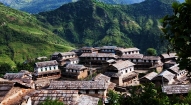
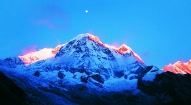
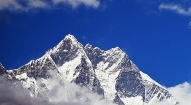
Day 01: Arrive Kathmandu International Airport- T I A (1300m) and transfer to hotel.
Day 02: After breakfast we set out for an extensive guided sightseeing tour of Kathmandu valley’s cultural, historical, religious and (world heritage) sites. During the course, we visit the famous Pashupatinath temple of Lord Shiva situated at the holy bank of River Bagmati where we will also observe the Hindu cremation ritual. We then proceed to the Boudhanath stupa, a major pilgrimage centre for the Buddhist faith which also is the largest of its kind in the world. We then have a short break for lunch followed by a visit to Swoyambhunath stupa also known as the Monkey Temple from where we can have a bird’s eye view of whole of Kathmandu valley. Following this we then proceed for a visit to Kathmandu Durbar Square, the oldest royal palace of Kathmandu and a UNESCO world heritage site. The whole are of Kathmandu Durbar Square is dotted with numerous fascinating Nepalese architect dating back many centuries. The site is also the home to Nepal’s living Goddess – Kumari, where we will also have the opportunity to experience firsthand this unique Nepali tradition. In the evening we will attend the welcome dinner hosted by Makalu Adventure with live Nepalese culture shows.
Day 03: Kathmandu ( 1310m) - Lukla (2827m)
After a very early start, and an early take off from Kathmandu Domestic Airport, a 45 minute flight is all it takes to propel us into the Everest region of Nepal. The landing at Lukla (2800m) is spectacular and on arrival we are greeted by our sirdar and trekking crew who organise the luggage and hustle us off for tea. Rest of the day at leisure and relax or you could explore the town on your own. Camping.
Days 04-05: Walking for 3 to 4 hours due east from Lukla, the trail passes through a number of tiny hamlets and wood yards until it enters thick forest on the hillside below the Kalo Himal Ridge. There are many streams with numerous places for the first camp, all of which are loosely referred to as Chutanga. Camping.
Climb to a high camp in preparation for the pass.
Day 06: The first objective of the trek is to cross the Kalo Himal Ridge which separates the Khumbu from the Hinku Valley. There are two passes, the easiest of which is the Zatrwa La. A good path exists all the way across the pass and it is frequently crossed by Yak herders and their beasts. However, under fresh snow this pass can be quite difficult, especially for the porters. A steep climb brings one to a cairned notch in the ridge with a collection of prayer flags. This is not the pass! The path traverses across a boulder slope, rounds a corner and climbs once more to the pass proper. Care should be taken in bad weather, when route-finding can be a little tricky if you are not a Yak! In good weather, the views across the Dudh Kosi towards Karyolung and the Lumding Himal are very impressive, as is the view across the rolling foothills east of the Hinku Valley. Half an hour below the pass is a huge boulder which marks the spot of our camp at Thuli Kharka. Camping.
The path descends to a fine vantage point of the Hinku Valley, with impressive views of the South Face of Mera Peak. Entering the forest once again, the trail drops steeply down in the Hinku Valley. The forest of the Hinku Valley is a delight to walk through, full of tall Himalayan pine and rhododendron. Finally, a camp is made by the Hinku Drangka River at a place known as Tashing Dingma. Camping.
Day 07: Following the west bank of the Hinku Drangka northward, the forest eventually disappears and the valley widens and becomes much more open. There are no villages in the Upper Hinku, only small kharkas (meadows) used for grazing goats and Yaks. 4-6 hours upstream, after passing a single plank bridge at Gondishung, is the interesting summer settlement of Tangnag, with its huts and stone wall field enclosures. Gondishung itself has a fascinating gompa and a crude Mani wall. Peak 43 is the pyramidal peak which dominates this section of the walk and Mera’s impressive serac-hung west face is ever-present on the right. Camping.
Day 08 - 09: The Upper Hinku Valley turns east at Tangnag, crossing the moraine of the Dig Glacier. After a couple of hours the angle of the climb relents and the path leads into a wide grassy basin which goes by the name of Dig Khare (16,440’), Mera Peak Base Camp. There are numerous sites for a camp, but the most popular seems to be slightly higher by a group of boulders. Camping.
At this point your trekking group can spend day or two exploring the area with day hikes to various view points, then begin a trek back to Lukla. Those booked to attempt to summit the Mera Peak will proceed as follows:
Days 10 - 12: The group begins its acclimatization by moving up towards to the Mera La (5415m). Following the trail up the moraine from Khare, numerous cairns and prayer flags are passed before skirting from left to right below a cliff to gain the first sight of the tongue of ice which gives access to the Mera Glacier. Crampons are often needed on the glacier (depending on snow conditions) and there are usually open crevasses which make it necessary for the group to rope up. Camping.
Three days have been set aside for acclimatization and extensive training in beginning and intermediate mountaineering skills at base camp and at our high camp. Depending on conditions the camp can be set on the pass itself or at the traditional high camp (19,070’). The decision will be made by the group leader. After the days spent in training and preparation every participant should be qualified as a technically competent member of a rope team. The climbing group will spend time drinking as much tea and soup as possible to help with acclimatization. Camping.
Day 13: At 2 or 3 am, after bed tea and a hurried breakfast, the group will set out for the summit. By sunrise the short steepening of the climb at 19,728’ should have been reached. Several false summits lead finally to a view of the central summit (21,247’), which is climbed from its left side. The view from the summit is one of the best in the entire Himalaya. No less than 5 of the world’s fourteen 8000m peaks can be seen. Most of this spectacular panorama can be seen from the site of the high camp and all of it is visible during the climb, so don’t worry if you don’t make it all the way to the top. The group will descend all the way back to the Mara La and camp on the northern side. Camping.
Day 14: Leaving the camp we trek up the Hongu Valley towards Panch Pokari.
Day 15: Climb eastwards towards Baruntse Base Camp at 17,000’.
Day 16: Fix rope to the West Col. Effectively Camp One on Baruntse.
Day 17: Move up to the West Col to camp. 19,000+’. A dramatic campsite on the snow.
Day 18: Sunrise at the West Col. Cross the plateau to the east to Sherpani Col 19,000’. Views of the west face of Makalu. Return to West Col and descend to base camp.
Day 19: Descend to the main valley and ascend to Panch Pokari, which means five lakes in Nepali. Panch Pokhari is reputed to be the sight of a mythical Bayelor Shangrila. Another very dramatic campsite. Camping.
Day 20: Rest Day. Explore and photograph.
Day 21: We cross the Amphu Lapsa pass and make a series of steep rappels down a rock cliff into the Upper Chukung Valley. Camping.
Day 22: Return down valley via Dingboche, a summer village in a spectacular setting. Continue through a beautiful rhododendron forest to the monastery of Thyangboche (3860m). Destroyed by fire in 1989, this gompa has since been reconstructed. From Thyangboche the mountain panorama is one of the most breathtaking in the Khumbu. From this vantage point, the massive Nuptse-Lhotse wall conceals all but the tip of Everest. Rising above the monastery is “Mothers Charm Box”, Ama Dablam (6848m). The name stems from a mountain formation said to resemble a dablam, a charm box worn by female residents of the Khumbu and Tibet.
Day 23: Descend to Namche Bazzar via Khumjung village.
Day 24: Trek down valley following the Dudh Kosi River to Lukla. We have our festive Farewell Dinner with our staff and guides so be prepared for great food and dancing into the wee hours. Camping.
Day 25: Flight from Lukla to Kathmandu. Transfer to hotel. Hotel.
Day 26: Free day in Kathmandu, or extra day in case of bad weather. Hotel.
Day 27: Depart Kathmandu.
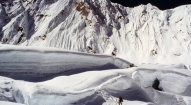
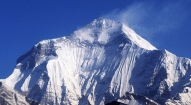
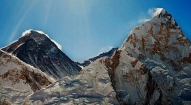
- All ground transfer by private vehicles as per our itinerary
- Fine hotel –Thamel Eco Resort in Kathmandu (twin sharing including b/f and taxes)
- Welcome dinner with live Nepalese cultural program hosted by Makalu Adventure
- Guided sightseeing around Kathmandu world heritage sites including all entrance fees
- All domestic airfares (Kathmandu-Lukla- Kathmandu)
- Organized camping trek arrangements including all high quality German Salewa / UK Super Quasar camping equipment such as two men tent, kitchen tent, dining tent, toilet tent, tables, chairs, mattresses, hot water bags, pillows, inner sheets etc.
- Everyday three times hot meals while on trekking prepared by our professional kitchen crew.
- National park, conservation area permit and fees
- Guide, porters, their daily wages, insurances with all necessary lodging / fooding arrangements.
- Administration service during rescue and evacuation (if required)
- Down jacket, sleeping bags, Trekking kit bag/duffel bag, trekking map and trekking Poles
- A comprehensive medical kit
- All government and local taxes
- Nepal visa fee.
- Airport taxes.
- International airfare to and from Kathmandu.
- Excess baggage charges.
- Lunch and evening meals in Kathmandu.
- Extra night accommodation.
- Travel and rescue insurance.
- Personal expenses (phone calls, laundry, bar bills, battery recharge, extra porters, bottle or boiled water, showers etc).
- Rescue and evacuation if required.
- Tips gratitude





